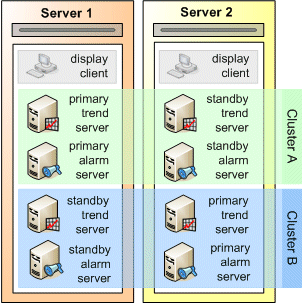
Load sharing of system components across different computers and CPUs means the work load of a potentially stressed system can be split across multiple machines, better utilizing the available infrastructure.
For example, managing alarms can draw heavily on a CPU's performance, while trending data can use a lot of disk space. By assigning your Trends and Alarm Servers to different processes on a shared computer, an Alarm Server can be used as a standby Trends Server, making practical use of idle disk space.
This approach can used to improve network performance, data access times, and general system stability.
If you introduce clustering, you have the flexibility to run multiple servers of the same type on a single computer. As long as a client has access to every cluster configured in a project, it doesn't matter if a set of servers is distributed across a number of clusters.
In the diagram below, two servers have been configured to act as standby units for each other, supporting two sets of redundant Trends and Alarm Servers.

Both machines have an even balance of Trends and Alarm Servers, making effective use of the CPU and disk space. By distributing the servers across two clusters, the servers are also able to act as redundant units to each other. This has reduced the necessary number of computers from a maximum of eight down to just two.